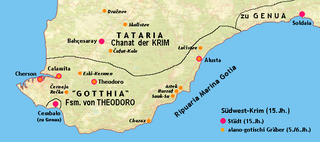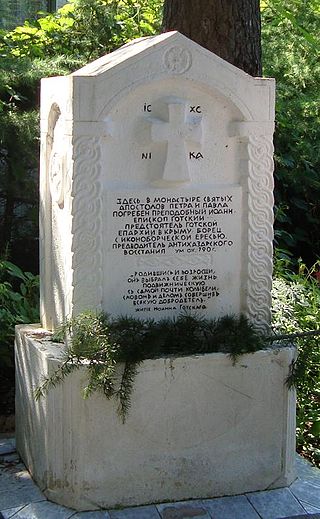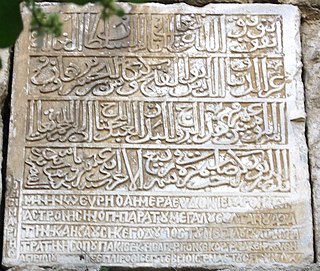
The Empire of Trebizond or the Trapezuntine Empire was a successor state of the Byzantine Empire that existed during the 13th through to the 15th century. The empire consisted of the Pontus, or far northeastern corner of Anatolia, and portions of southern Crimea.

The Crimean Goths were Greuthungi-Gothic tribes or Western Germanic tribes who bore the name Gothi, a title applied to various Germanic tribes who remained in the lands around the Black Sea, especially in Crimea. They were the longest-lasting of the Gothic communities. Their existence is well attested through the ages, though the exact period when they ceased to exist as a distinct culture is unknown; as with the Goths in general, they may have become diffused among the surrounding peoples. In his Fourth Turkish letter, Ogier Ghiselin de Busbecq (1522–1592) describes them as "a warlike people, who to this day inhabit many villages".

Mangup also known as Mangup Kale is a historic fortress in Crimea, located on a plateau about 13 kilometres east of Sevastopol.

John of Gothia was a Crimean Gothic metropolitan bishop of Doros, and rebel leader who overthrew and briefly expelled the Khazars from Gothia in 787. He was canonized as an Eastern Orthodox saint.
Michael Panaretos was an official of the Trapezuntine empire and a Greek historian. His sole surviving work is a chronicle of the Trapezuntine empire of Alexios I Komnenos and his successors. This chronicle not only provides a chronological framework for this medieval empire, it also contains much valuable material on the early history of the Ottoman Turks from a Byzantine perspective, however it was almost unknown until Jakob Philipp Fallmerayer discovered it in the nineteenth century among the manuscripts of the Biblioteca Marciana of Venice. "Owing to this drab but truthful chronicle," writes the Russian Byzantist Alexander Alexandrovich Vasiliev, "it has become possible to a certain extent to restore the chronological sequence of the most important events in the history of Trebizond. This Chronicle covers the period from 1204 to 1426 and gives several names of emperors formerly unknown."

Andronikos I Gidos, Latinized as Andronicus I Gidus or Gidon, was an Emperor of Trebizond (1222–1235). He is the only ruler of Trebizond who was not a blood relative of the founder of that state, Alexios I Megas Komnenos. George Finlay suggests he may be the same Andronikos who was a general of Theodore I Laskaris. During his reign, Trebizond successfully withstood a siege of the city by the Seljuk Turks, and later supported the Khwarazmshah in the latter's unsuccessful battle with the Seljuks.
Alexios I Megas Komnenos or Alexius I Megas Comnenus with his brother David, the founder of the Empire of Trebizond and its ruler from 1204 until his death in 1222. The two brothers were the only male descendants of the Byzantine Emperor Andronikos I, who had been dethroned and killed in 1185, and thus claimed to represent the legitimate government of the Empire following the conquest of Constantinople by the Fourth Crusade in 1204. Although his rivals governing the Nicaean Empire succeeded in becoming the de facto successors, and rendered his dynastic claims to the imperial throne moot, Alexios' descendants continued to emphasize both their heritage and connection to the Komnenian dynasty by later referring to themselves as Megas Komnenos.
Alexios IV Megas Komnenos or Alexius IV, Emperor of Trebizond from 5 March 1417 to 26 April 1429. He was the son of Emperor Manuel III and Gulkhan-Eudokia of Georgia.

Alexander Alexandrovich Vasiliev was considered the foremost authority on Byzantine history and culture in the mid-20th century. His History of the Byzantine Empire remains one of a few comprehensive accounts of the entire Byzantine history, on the par with those authored by Edward Gibbon and Fyodor Uspensky.

The Principality of Theodoro, also known as Gothia (Γοτθία) or the Principality of Theodoro-Mangup, was a Greek principality in the southern part of Crimea, specifically on the foothills of the Crimean Mountains. It represented one of the final rump states of the Eastern Roman Empire and the last territorial vestige of the Crimean Goths until its conquest by the Ottoman Empire by the Ottoman Serb Gedik Ahmed Pasha in 1475. Its capital was Doros, also sometimes called Theodoro and now known as Mangup. The state was closely allied with the Empire of Trebizond.
Manuel Komnenos was the eldest son of Byzantine emperor Andronikos I Komnenos, and the progenitor of the Grand Komnenos dynasty of the Empire of Trebizond. He served his uncle, Manuel I Komnenos, as a diplomatic envoy to the Russian principalities and the Kingdom of Jerusalem, but also helped his father escape imprisonment in Constantinople. His opposition to the regency of Empress-dowager Maria of Antioch and the protosebastos Alexios Komnenos landed him in prison, but he was released in April 1182, when his father stood poised to take power in the Byzantine capital.
Constantine Gabras or Gavras was the governor or doux (duke) of the Byzantine province of Chaldia, centred on the Black Sea port of Trebizond and its mountainous hinterland, the Pontic Alps, in northeast Anatolia, now part of Turkey. Gabras ruled Chaldia as a semi-independent prince between 1126 and 1140.

Vazelon Monastery is a ruin located in the Black Sea region of Turkey. It was built in 270 and is 40 km (25 mi) south of Trabzon. Justinian I, a ruler of the Byzantine Empire, ordered the monastery to be repaired in 565, and it was renovated multiple times until the 20th century. The current structures date from the rebuilding in 1410.
Maria of Gothia was the first wife of David of Trebizond, last Emperor of Trebizond, whom she married in 1426.

Gabras or Gavras feminine form Gabraina (Γάβραινα), is the name of an important Byzantine aristocratic family which became especially prominent in the late 11th and early 12th centuries as the semi-independent and quasi-hereditary rulers of Chaldia.
Alexander Vasilyev may refer to:
The Metropolitanate of Gothia, also known as the Eparchy of Gothia or Metropolitanate of Doros, was a metropolitan diocese of the Patriarchate of Constantinople in the Middle Ages.

The siege of Sinope in 1214 was a successful siege and capture of the city by the Sultanate of Rum under their Sultan, Kaykaus I. Sinope was an important port on the Black Sea coast of Anatolia, at the time held by the Empire of Trebizond, one of the Byzantine Greek successor states formed after the Fourth Crusade. The siege is described in some detail by the near-contemporary Seljuq chronicler Ibn Bibi. The Trapezuntine emperor Alexios I led an army to break the siege, but he was defeated and captured, and the city surrendered on 1 November.
Gregory Taronites was a Byzantine governor of the theme of Chaldia who rebelled against Emperor Alexios I Komnenos in 1103/4 and governed his province as a virtually independent ruler until his defeat in battle in 1106/7. He was then imprisoned for some time in the Prison of Anemas, before obtaining an imperial pardon. Some scholars have proposed an identification with Gregory Gabras, but this is disputed.

Maria Asanina Palaiologina, better known as Maria of Mangup or Maria of Doros, was the second wife of Prince Stephen the Great and as such Princess consort of Moldavia from September 1472 to 1475 or 1477. Of uncertain parentage, but most likely a descendant of imperial Bulgarian and Byzantine dynasties, she belonged to the ruling class of the small Crimean Principality of Theodoro. Her close relatives included both warring princes of Theodoro, Alexios II and Isaac, as well as Zuan Tzamplakon, diplomat and leader of Stratioti.











